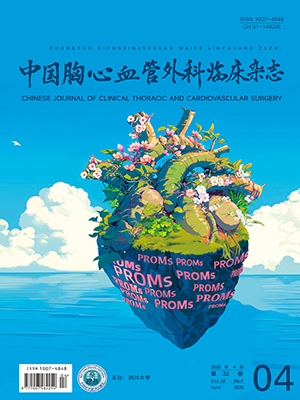Objective To evaluate outcomes of vacuum sealing drainage(VSD)for the treatment of wound infection after cardiac surgery.?Methods?We retrospectively analyzed clinical data of 70 patients(with valvular heart disease,congenital heart disease or coronary heart disease)who underwent cardiac surgery via mid-sternotomy and had postoperative wound infection from Jan. 2008 to Jan. 2012 in General Military Hospital of Guangzhou Command. According to different treatment strategy for wound infection, all the patients with wound infection (incision longer than 5 cm) were randomly divided into VSD group (n=35) and control group(n=35) by random number table,while VSD treatment was used for patients in VSD group and routine treatment was used for patients in control group. Treatment outcome,duration of wound infection, duration of antibiotic treatment and treatment cost were compared between the two groups.?Results?There was no in-hospital death in both groups. Wound exudate significantly decreased and fresh granulation tissue grew well in the wound in most VSD group patients after VSD treatment. The cure rate of VSD group was significantly higher than that of control group (94.3% vs. 60.0%,P<0.05). Duration of wound infection (12.9±3.4 d vs. 14.8±4.1 d;t=-2.094,P=0.040)and duration of antibiotic treatment (7.0±1.5 d vs. 8.3±1.9 d;t=-2.920,P=0.005) of VSD group were significantly shorter than those of control group. There was no statistical difference in treatment cost between the two groups. Fifteen patients in VSD group were followed up (42.9%) for 3 months with good wound healing, and 20 patients in VSD group were lost in follow-up.?Conclusion?VSD is effective for the treatment of wound infection after cardiac surgery with shortened treatment duration and similar treatment cost compared with routine treatment.
Citation:
WANG Xianyue,WANGXiaowu,BI Shenghui,MEI Lugang,LIANG Aiqiong,XU Yu,ZHANG Weida.. Vacuum Sealing Drainage for Patients with Wound Infection after Cardiac Surgery. Chinese Journal of Clinical Thoracic and Cardiovascular Surgery, 2012, 19(5): 529-533. doi:
Copy
Copyright © the editorial department of Chinese Journal of Clinical Thoracic and Cardiovascular Surgery of West China Medical Publisher. All rights reserved
| 1. |
蒋雷, 陈晓峰. 胸心外科手术预防性抗感染治疗研究进展. 中国胸心血管外科临床杂志, 2007, 14 (2):135-138.
|
| 2. |
朱敬民, 郝天智, 贺立新, 等. 经胸骨正中手术切口感染创面的修复. 中国修复重建外科杂志, 2007, 21 (12):1323-1325.
|
| 3. |
洪塞里, 辛特克, 主编. 心脏外科学手术技术安全措施及失误防范. 上海:上海科学技术出版社, 2005. 8-12.
|
| 4. |
黄信生, 顾承雄, 谢进生, 等. 双侧乳内动脉Y型桥冠状动脉旁路移植术中远期临床疗效分析. 中国胸心血管外科临床杂志, 2009, 16 (4):254-258.
|
| 5. |
Miwa K, Takamori S, Mitsuoka M, et al. Successful treatment of sternal osteomyelitis after pneumonectomy using a pedicled omental flap. Jpn J Thorac Cardiovasc Surg, 2001, 49 (8):522-524.
|
| 6. |
才志刚, 张绍明, 张珩, 等. 心脏术后胸骨骨髓炎和纵隔炎使用腹直肌带蒂肌皮瓣修复创面. 上海医学, 2008, 31 (4):256-258.
|
| 7. |
Koehler C, Niederbichler AD, Jung FJ, et al. Wound therapy using the vacuum-assisted closure device:clinical experience with novel indications. J Trauma, 2008, 65 (3):722-731.
|
| 8. |
Timmers MS, Graafland N, Bernards AT, et al. Negative pressure wound treatment with polyvinyl alcohol foam and polyhexanide antiseptic solution instillation in posttraumatic osteomyelitis. Wound Repair Regen, 2009, 17 (2):278-286.
|
| 9. |
李跃军, 曹大勇, 陈绍宗. 封闭负压引流技术对创面愈合过程纤溶酶原激活剂级联表达的影响. 中华整形外科杂志, 2006, 22 (4):306-309.
|
| 10. |
石冰, 张萍, 李望舟, 等. 封闭负压引流技术对人慢性创面中胶原酶活性的影响. 中华整形外科杂志, 2006, 22 (6):465-467.
|
| 11. |
杨桂元, 钱祝银. 负压封闭引流技术研究进展. 中国实用外科杂志, 2010, 30 (2):149-151.
|
| 12. |
冯建国, 刘志勇. 心脏外科术后正中切口感染的防治. 东南大学学报:医学版, 2010, 29 (6):711-713.
|
| 13. |
冯东, 王云, 顾继伟, 等. 冠状动脉搭桥术后胸部切口感染5例分析. 宁夏医科大学学报, 2011, 33 (4):385-387.
|
| 14. |
Singh K, Anderson E, Harper JG. Overview and management of sternal wound infection. Semin Plast Surg, 2011, 25 (1):25-33.
|
| 15. |
李新, 万居易, 付勇, 等. 体外循环心内直视手术后胸骨哆开保守治疗初探. 四川医学, 2011, 32 (12):1900-1902.
|
| 16. |
Simek M, Hajek R, Fluger I, et al. Superiority of topical negative pressure over closed irrigation therapy of deep sternal wound infection in cardiac surgery. J Cardiovasc Surg (Torino), 2012, 53 (1):113-120.
|
| 17. |
Petzina R, Hoffmann J, Navasardyan A, et al. Negative pressure wound therapy for post-sternotomy mediastinitis reduces mortality rate and sternal re-infection rate compared to conventional treatment. Eur J Cardiothorac Surg, 2010, 38 (1):110-113.
|
- 1. 蒋雷, 陈晓峰. 胸心外科手术预防性抗感染治疗研究进展. 中国胸心血管外科临床杂志, 2007, 14 (2):135-138.
- 2. 朱敬民, 郝天智, 贺立新, 等. 经胸骨正中手术切口感染创面的修复. 中国修复重建外科杂志, 2007, 21 (12):1323-1325.
- 3. 洪塞里, 辛特克, 主编. 心脏外科学手术技术安全措施及失误防范. 上海:上海科学技术出版社, 2005. 8-12.
- 4. 黄信生, 顾承雄, 谢进生, 等. 双侧乳内动脉Y型桥冠状动脉旁路移植术中远期临床疗效分析. 中国胸心血管外科临床杂志, 2009, 16 (4):254-258.
- 5. Miwa K, Takamori S, Mitsuoka M, et al. Successful treatment of sternal osteomyelitis after pneumonectomy using a pedicled omental flap. Jpn J Thorac Cardiovasc Surg, 2001, 49 (8):522-524.
- 6. 才志刚, 张绍明, 张珩, 等. 心脏术后胸骨骨髓炎和纵隔炎使用腹直肌带蒂肌皮瓣修复创面. 上海医学, 2008, 31 (4):256-258.
- 7. Koehler C, Niederbichler AD, Jung FJ, et al. Wound therapy using the vacuum-assisted closure device:clinical experience with novel indications. J Trauma, 2008, 65 (3):722-731.
- 8. Timmers MS, Graafland N, Bernards AT, et al. Negative pressure wound treatment with polyvinyl alcohol foam and polyhexanide antiseptic solution instillation in posttraumatic osteomyelitis. Wound Repair Regen, 2009, 17 (2):278-286.
- 9. 李跃军, 曹大勇, 陈绍宗. 封闭负压引流技术对创面愈合过程纤溶酶原激活剂级联表达的影响. 中华整形外科杂志, 2006, 22 (4):306-309.
- 10. 石冰, 张萍, 李望舟, 等. 封闭负压引流技术对人慢性创面中胶原酶活性的影响. 中华整形外科杂志, 2006, 22 (6):465-467.
- 11. 杨桂元, 钱祝银. 负压封闭引流技术研究进展. 中国实用外科杂志, 2010, 30 (2):149-151.
- 12. 冯建国, 刘志勇. 心脏外科术后正中切口感染的防治. 东南大学学报:医学版, 2010, 29 (6):711-713.
- 13. 冯东, 王云, 顾继伟, 等. 冠状动脉搭桥术后胸部切口感染5例分析. 宁夏医科大学学报, 2011, 33 (4):385-387.
- 14. Singh K, Anderson E, Harper JG. Overview and management of sternal wound infection. Semin Plast Surg, 2011, 25 (1):25-33.
- 15. 李新, 万居易, 付勇, 等. 体外循环心内直视手术后胸骨哆开保守治疗初探. 四川医学, 2011, 32 (12):1900-1902.
- 16. Simek M, Hajek R, Fluger I, et al. Superiority of topical negative pressure over closed irrigation therapy of deep sternal wound infection in cardiac surgery. J Cardiovasc Surg (Torino), 2012, 53 (1):113-120.
- 17. Petzina R, Hoffmann J, Navasardyan A, et al. Negative pressure wound therapy for post-sternotomy mediastinitis reduces mortality rate and sternal re-infection rate compared to conventional treatment. Eur J Cardiothorac Surg, 2010, 38 (1):110-113.




